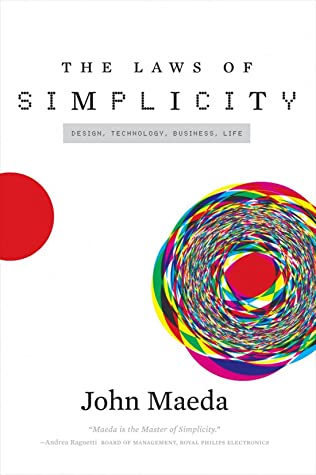The Laws of Simplicity by John Maeda
The Laws of Simplicity by John Maeda was a nice overview of the methods by which we can take the complex things in our lives, and simplify them.

The Laws of Simplicity by John Maeda was a nice simple introduction to the methods by which we can take the complex things in our lives, and simplify them. I started this book looking for a quick easy read and I was not disappointed.
First of all, the book adheres to its own policy of being simple. It is exactly 100 pages which means that in addition to being short, at any point in time, no matter what page you are on, you have an easy conversion to what percentage of the book you have completed. Page 25? 25%. Page 50? 50%. Even page 1... 1%.
Next, for every law introduced in the book, there is an associated image to represent it. Not all of the images were intuitive, but most were. Finally, a number of the laws had mnemonics that made them easier to remember. All these things combined made the already short book, a pleasure to read. Now let's talk about the Laws:
The first one was called "Reduce." The mnemonic was S.H.E. i.e. Shrink, Hide, Embody. By applying these 3 techniques, one can reduce the complexity they are faced with. The iPhone provides an excellent example. It embodies Simplicity with a clean design and only one main button. Displayed on the screen at any point in time are just the functions you need. E.g. the on-screen keyboard is hidden until you need to type. Also, all the apps are represented by small icons, which expand into their functional applications when you tap on them and shrink back into icon form when you exit.
The next law was called "Organise." Like the law before it, this law also had a mnemonic called SLIP: Sort, Label, Integrate, Prioritise. And so it went from law to law with mnemonics where applicable, and images, and descriptions. In total there were 10 laws as listed below:
- Reduce: The simplest way to achieve simplicity is through thoughtful reduction
- Organise: Organisation makes a system of many, appear fewer
- Time: Savings in time feel like simplicity
- Learn: Knowledge makes everything simpler
- Differences: Simplicity and Complexity need each other
- Context: What lies in the periphery of simplicity is definitely not peripheral
- Emotion: More emotions are better than less
- Trust: In simplicity we trust
- Failure: Some things can never be made simple
- The One: Simplicity is about subtracting the obvious, and adding the meaningful.
So while all the laws had something to teach, the final law, #10, was meant to be the one thing you take away from the book if you could only take one thing.
Simplicity is about subtracting the obvious, and adding the meaningful.
With all these steps the author took to make the book easy to digest, even going as far as highlighting the one takeaway readers of the book should have if nothing else, I have to say that the author achieved his goal. For me, The Laws of Simplicity was a simple delight - and if you deign to pick it up too, I'm sure you will find the same.

The Laws of Simplicity by John Maeda
A simple introduction to how to make life simpler